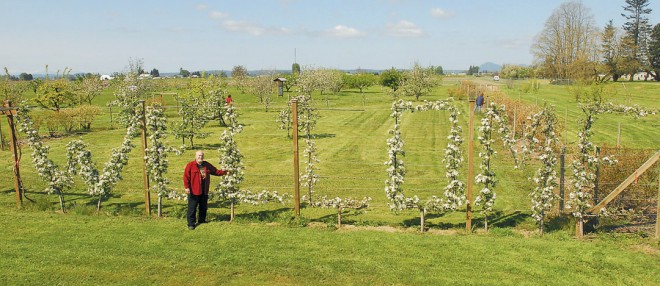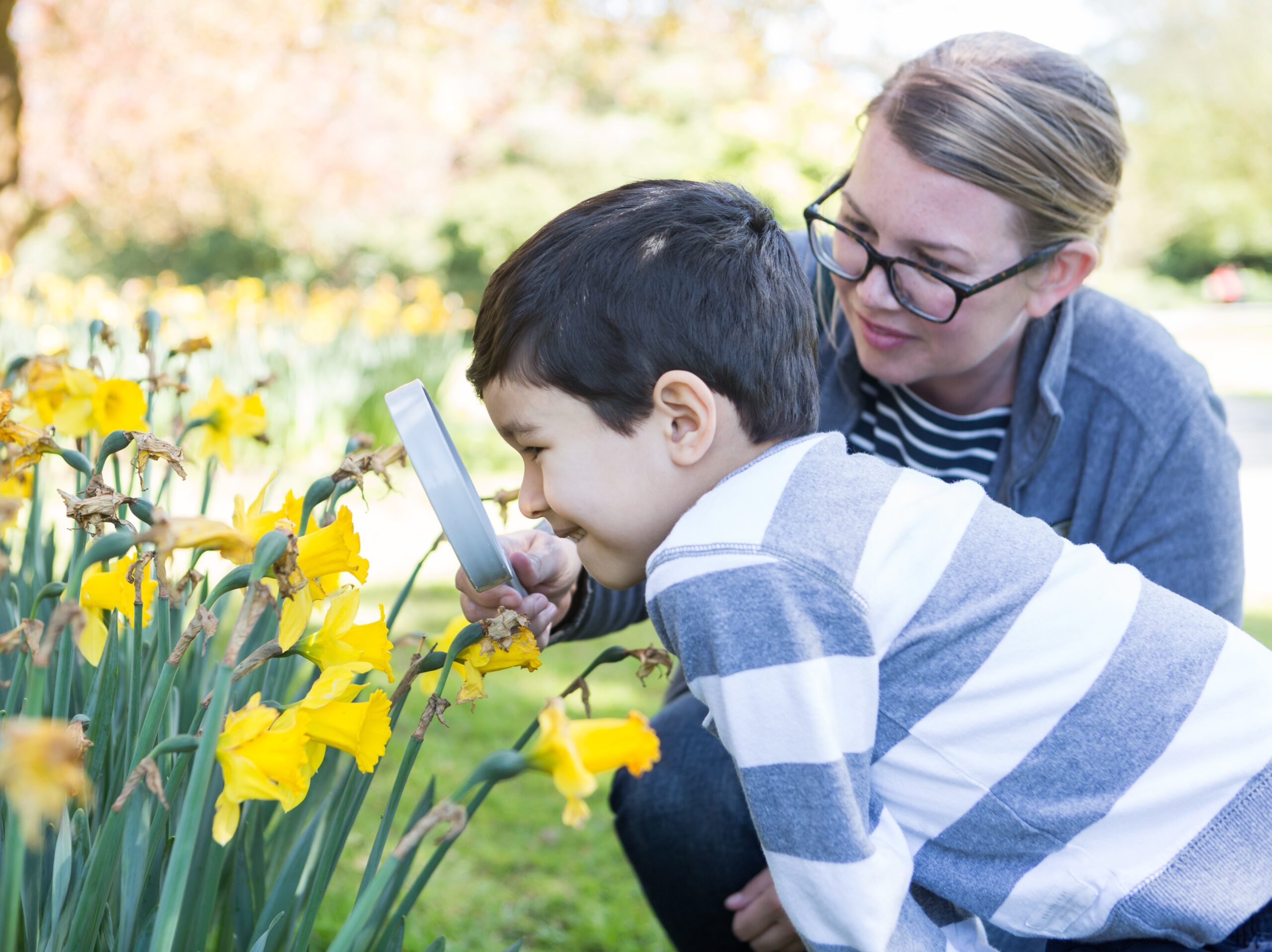
Well-bred Fruit (for the Maritime Climate)

Contributor

The mission of the Western Washington Fruit Research Foundation is to advance fruit horticultural programs for our unique Western Washington maritime climate through advocacy, research, education, and demonstration for the benefit of the general public and the small farmer.
Set near the Puget Sound in northern Washington, the Fruit Garden was created by the Western Washington Fruit Research Foundation (WWFRF) at Washington State University’s Mount Vernon Research Center. The garden is intended to serve visiting fruit enthusiasts who want to be “Growing Great Fruit!” (as conveyed in the WWFRF’s logo). Designed in 1997, the Fruit Garden has a formal layout featuring broad allées with long view corridors ending in large walnut trees as focal points. Broad pathways permit both large equipment and crowds to circulate freely throughout the garden. Narrow secondary paths allow for a slower and more intimate interaction with the various edibles.

Strolling down rows of apple trees collected from around the world is like stepping into the Garden of Eat’in. This seven-acre garden offers an alluring exploration of 172 fruit varieties and 571 fruiting trees and bushes, among them sixteen different green and red strains of the ‘Gravenstein’ apple—the most complete collection in the world.
Beyond a row of fifteen different cherry varieties trained in an open, V-shaped Tatura trellis, the expansive grassy meadow in the heart of the Fruit Garden is surrounded by an oval of large antique apple trees. Twenty-six varieties make up one of the best antique apple collections in the region; they provide scion wood for regenerating old orchards and allow for evaluation of natural anthracnose resistance. Some of the trees stem from an era when early sailors would load up barrels full of apples packed in sawdust to ward off scurvy on long sea voyages.
Over the years, many of the best varieties bred specifically for cool, moist Pacific Northwest growing conditions have been transplanted from the university’s fruit research trials into the Fruit Garden. Pruning methods are showcased in the 600 feet of extensive espaliers (including a fifty-foot-long WELCOME espalier). The garden also demonstrates the distinctions between the various types of rootstocks on which fruit trees can be grafted. More educational kiosks are being added, along with handouts on a variety of topics, such as the popular drip irrigation display.
Within the original design of the Fruit Garden are several smaller gardens, including two contrasting gardens yet to be completed. The first will tell the story of a typical Pioneer Garden from the late 1800s, at which time the main criteria for “good” fruit was its ability to keep in cellars for long periods of time after harvesting. The Contemporary Garden will highlight the best-tasting varieties on multi-grafted trees that use the latest dwarfing and inter-stem rootstocks and have been bred for excellent disease resistance. Here, the emphasis will be on practical organic and sustainable methods for homeowners.
The horticultural cognoscenti use the Fruit Garden to learn first hand about local fruit growing. Visiting fruit fans are welcome from dawn to dusk year round, and are invited to join the hardworking Fruit Garden volunteers on Thursday mornings.

Early Evaluations
In 1962, Dr Robert Norton started the tree fruit evaluation project shortly after he began working at the Mount Vernon Research Center. Norton observed that many of the tree fruit varieties available to local home gardeners were not well suited to our climate, being prone to diseases or needing more heat to develop quality fruit. With his background in pomology, Norton set out to test tree fruit varieties, both new and old, to determine the ones that would be better adapted to Western Washington gardens.
In 1991, WSU eliminated its fruit horticulture research position due to budgetary constraints. The WWFRF was established to help fund the continuation of the tree fruit evaluation and research program. Though modest in scale and cost, the work of WWFRF is unparalleled, being both the envy and model for researchers and gardeners throughout the world. Leading scientists from institutions such as Cornell University have been inspired by the research program’s accomplishments, and are interested in emulating the working relationship between the WSU Mount Vernon Research Center and WWFRF as budgets decline for research programs throughout the United States and much of the world.

WWFRF is the largest non-commercial and nonprofit fruit research support group in the US. Since its founding twenty years ago, the donations and fund-raising activities of some 5,000 members have contributed over $250,000 to ongoing fruit research at the Mt Vernon Research Center. WWFRF has a strong emphasis on education, as well as research. Seasonal Field Days offer classes and demonstrations on everything from pollination, pest control, pruning, and grafting, to cooking and using fruit. Along with these all-day events, there are Cherry Tasting Days and Apple, Pear, and Cider Tasting Days each year.
Local Discoveries
Nearby successful fruit cultivars have often been discovered in the backyard gardens of local homeowners; such discoveries then undergo years of multiple tree testing in the WSU Mount Vernon Research Center trial fields. Herb Frost, for example, provided the FROST peach to be tested at the station; it remains the leading leaf curl-resistant peach. Margaret Proud also provided a chance leaf curl-resistant seedling for research; now, the patented peach, called AVALON PRIDE, is sold in England and the United States.
The Copeland Family discovered an apricot seedling at the Anacortes ferry landing and named it ‘Puget Gold’ after it proved reliable. Joe Long, a short ferry ride away on Orcas Island, found the ORCAS pear, which is still among the best for our region. Knox Nomura, of Sumner (near Seattle), provided the ‘Rescue’ pear, and gave the station a selection of Asian pears (Pyrus serotina), from which extensive trials have determined ‘Shinseiki’, ‘Chojuro’, and ‘Kosui’ to be among the best Asian pears.
The fruit research program has yielded collaborations with other programs throughout the world. Working with Cornell University, WWFRF has helped introduce new types of plums, including a gage plum (ROSY GAGE), two new damson types (BLUE’S JAM and JAM SESSION), a Mirabelle type plum (GENEVA MIRABELLE), and a crack-resistant Sehome strain of ‘Italian Prune’. Work with Russian researchers resulted in the introduction of the KUBAN DELIGHT plum. This small round fruit wins taste tests for its juicy combination of tart reddish purple skin and sweet yellow orange flesh. It is a productive, disease-resistant selection that ripens in early August—perfect for this region.

Superior Selections
The Mount Vernon Research Center tested a number of sweet cherry varieties that have proven superior, thriving on the newly introduced dwarfing ‘Gisela’ rootstocks. It is now possible to maintain trees at a height of only ten feet, making harvesting and protection from birds much easier. Among the best self-fertile sweet cherries are ‘Lapins’, ‘Vandalay’, BLACK GOLD, and WHITE GOLD, which are all more reliable at setting fruit in rainy Northwest springs than varieties that need a pollinator.
Successful, scab-immune apples introduced from other breeding programs include ‘Liberty’, ‘Prima’, ‘Williams’ Pride’, PRISTINE, ‘Enterprise’, ‘Belmac’, ‘Chehalis’, and ‘Spartan’. ‘Alkmene’, a naturally small tree with a lovely profuse bloom, and ‘Fiesta’ are both descendants of the famous ‘Cox’s Orange Pippin’ apple from England. These apples have some of the delicious Cox taste, without the extreme cracking and scab that Cox tend to have in our area. ‘Rubinette’ is a mildew-resistant Swiss hybrid of ‘Golden Delicious’, but it remains susceptible to scab. However, the balance of sweet and sharp flavors in ‘Rubinette’ makes it probably the best tasting apple variety. WWFRF is now collecting material to test a purportedly less susceptible scab variant called RUBINETTE ROSSO, which is redder and has a cleaner appearance.

Less Common Fruits
Researching distant sources for unusual fruits has resulted in the discovery of some of the best types of persimmons (Diospyros spp.), figs (Ficus carica), quince (Cydonia oblonga), paw paws (Asimina triloba), mulberries (Morus alba xrubra), black currants (Ribes nigrum), red currants (R. rubrum), gooseberries (R. hirtellum), aronias (Aronia melanocarpa), blue honeysuckle (Lonicera caerulea), Shipova (Pyrus X Sorbus, a unique pear and mountain ash cross from Yugoslavia,) and many other fruits for the gardeners of our region.

The Fruit Garden has access to plants that have not yet been released to the public, such as a collection of second-generation, columnar apples and the blue honeysuckles: Japanese haskap (Lonicera caerulea var. emphyllocalyx) and Russian honeyberry (L. caerulea var. kamtchatica and var. edulis). Similar in growth and appearance to blueberries, the cylindrical blue fruits of these honeysuckles ripen extremely early, even before strawberries.
Early ripening could make blue honeysuckles a good alternative for local organic blueberry growers, as researchers think they will not be susceptible to the latest Northwest scourge, the spotted wing drosophila (SWD). Working with researchers studying the effects of SWD at the Mount Vernon Research Center, WWFRF hopes to find ways to help minimize the negative impact of this new pest and explore new disease-control methods for the homeowner.
So, the next time you bite into a luscious locally grown fruit, think of the tree that produced it. Consider coming to the Fruit Garden and learning what to grow in your Pacific Northwest garden and how to grow it successfully. The results should prove mouthwatering and agreeable to the eye.
If You Should Like to Visit
The Western Washington Fruit Research Foundation’s Fruit Garden is located on the grounds of Washington State University’s Mount Vernon Research Center at 16650 State Route 536 (Memorial Highway) in Mount Vernon, WA, about an hour north of Seattle. For information on membership, visit www.NWFruit.org. Members include home gardeners, garden groups, commercial growers, and nurseries. Contact the author at fruitgarden@olympus.net for information about volunteering at the Fruit Garden on Thursday mornings.
Visit www.NWFruit.org to see the full schedule of activities for the Summer Fruit Festival and videos of past events.

Share:
Social Media
Garden Futurist Podcast
Most Popular
Videos
Topics
Related Posts

Ground Up Science for Greener Cities with Garden Futurist Dr. Alessandro Ossola
Spring 2023 Listen to the Podcast here. Alessandro Ossola is a scientist who gets very excited about the challenge of climate change allowing for an

Readying Urban Forests for Climate Realities with Garden Futurist Dr. Greg McPherson
Winter 2023 Listen to the Podcast here. “Going from the mow and blow to a more horticulturally knowledgeable approach to maintaining the landscape. And that

January Showers Bring February flowers…
Fall 2022 It may not quite have the same ring to it as the old English proverb, but it has a lot more truth to

Welcome, Greywater, to the Garden
Summer 2022 Oh, summer: delightful warm air, tomatoes swelling on the vine, fragrant blooms on an evening stroll. When it’s warm and rainless, how is










Responses